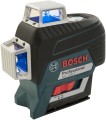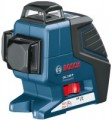Measurement range
The range at which the device remains fully operational without the use of additional receivers (see below); in other words, the radius of its action without auxiliary devices.
In some models, a range may be specified that shows the minimum (
3 cm,
5 cm) and maximum measurement ranges. But in most cases, only the maximum value is indicated.
The specific meaning of this parameter is determined by the type of instrument (see above). So, for optical levels, the measurement range is the greatest distance at which the operator can normally see the divisions of a standard leveling staff. For laser levels, this parameter determines the distance from the device to the surface on which the mark is projected, at which this projection will be easily visible to the naked eye; and in rangefinders we are talking about the greatest distance that can be measured. Typically, the measurement range is indicated for ideal conditions - in particular, in the absence of impurities in the air; in practice, it may be less due to dust, fog, or vice versa, bright sunlight "overlapping" the mark. At the same time, tools of the same type can be compared according to this characteristic.
Note that it is worth choosing a device according to the range of action, taking into account the features of the tasks that are planned to be solved with its help: after all, a large measurement range usually significa
...ntly affects the dimensions, weight, power consumption and price, but it is far from always required. For example, it hardly makes sense to look for a powerful laser level at 30-40 m if you need a device for finishing work in standard apartments.Measurement range (with receiver)
The longest measurement range provided by a laser level (see “Type”) when using a special receiver with a photocell.
Thanks to its sensitivity, such a receiver is able to respond even to a weak laser beam, the mark from which is no longer visible to the naked eye; At the same time, the area of the photocell is quite large, and special indicators make it possible to determine the exact position of the mark. Among other things, this significantly expands the range of action of the level - the measurement range with a receiver is usually several times greater than without it. On the other hand, such equipment inevitably affects the overall cost of the device; and in some models the receiver
is not included in the package at all; it must be purchased separately. However, the second option also has its advantages: you do not need to immediately pay for an additional accessory, it can be purchased later, when a real need arises, while some models allow you to choose the optimal receiver model from several options at your discretion.
Note that the receiver can be useful not only for increasing range; These points are described in detail in paragraph “Included parts”.
Auto power off
The time after which the device turns off by itself completely if the user does not perform any action.
See above for more information on auto power off; and his time has a double meaning. On the one hand, if this time is short, then the idle time of the device will be minimal, which helps to save energy. On the other hand, too frequent auto-shutdown (with subsequent switching on for work) is also undesirable — it increases the wear of components and reduces the resource, and it is not always convenient for the user. So manufacturers choose the time, taking into account the balance between these moments, as well as the general class and purpose of the device. So, in some rangefinders, this indicator does not even reach a minute, although in most such devices it is in the range from 3 to 8 minutes; and in some professional devices (primarily levels), the auto-off time can be 30 minutes or more (up to 3 hours).
Diode emission
The wavelength of the radiation emitted by the LED of the level or rangefinder; this parameter determines primarily the colour of the laser beam. The most widespread in modern models are LEDs with a wavelength of about 635 nm — at a relatively low cost, they provide bright red radiation, giving a well-visible projection. There are also green lasers, usually at 532 nm — the marks from them are even better visible, but such LEDs are quite expensive and rarely used. And radiation with a wave longer than 780 nm belongs to the infrared spectrum. Such a laser is invisible to the naked eye and is poorly suited for leveling, but it can be used in rangefinders — of course, with a viewfinder (see "Type" for more details).
Power source
The type and number of batteries used in the level/distance meter. All elements of standard sizes (
AA,
AAA,
C,
D,
PP3) are available in two formats — disposable batteries and rechargeable batteries. This gives the user a choice: either buy relatively inexpensive batteries every time, or invest once in a rechargeable battery with a charger, and then simply charge the battery as needed.
Branded batteries are, by definition, made only rechargeable, as are
18650 batteries.
Specific types of power today can be as follows:
— AA. A standard battery, known as a "finger battery". The power of these batteries is average, they can be used both in simple and quite advanced devices. This power supply is convenient due to the fact that AA batteries are very widespread and sold almost everywhere — due to this, finding and replacing them is usually not a problem.
— AAA. A smaller version of the AA element described above — almost identical in shape, but thinner and shorter. Such elements, known as "mini-finger" or "little fingers", have a rather low capacity and power, but are useful for portable devices, where compactness is crucial. They are also quite widespread.
— C. A cylindrical element, in the form of a rather thick "bar
...rel" — with a length of 50 mm, the diameter is 26 mm. Due to its higher capacity and power than AA, it is better suited for advanced models with "long-range" lasers, but is less commonly used and generally less common.
— D. The largest and most capacious type of standard batteries found in modern levels and distance meter: thickness and diameter are 62 and 34 mm, respectively. The main area of application for D batteries is powerful professional devices.
— Rechargeable battery. In this case, the tool is powered by an branded battery that does not belong to any standard size. This option is good because such batteries are initially created for a specific model of the level/distance meter and are supplied in the set (and in some models they are made non-removable); in addition, their specifications can significantly exceed those of standard elements of a similar size and weight. On the other hand, such power source is less convenient when the charge runs out at the wrong moment: the only way to remedy the situation is usually to recharge, and it takes quite a long time (whereas standard batteries can be replaced in just a minute).
– 18650. The name of these batteries comes from their dimensions: 18.6x65.2 mm, cylindrical, outwardly they resemble somewhat enlarged AA batteries, but they have an operating voltage of about 3.7 V and a higher capacity. In addition, all 18650 type batteries are by definition not disposable, but rechargeable batteries (lithium-ion type).
— PP3. 9-volt batteries of a spesific rectangular shape, with a pair of contacts on one of the ends. Due to the high operating voltage, they provide high power and actual capacity, so one such battery is usually enough for operation.
— LR44. Miniature batteries of "coin" type, 11.6 mm in diameter and 5.4 mm thick. Usually installed in sets of 3 and are used in compact low-power laser levels, for which small size is more important than power and capacity. Note that specifically the LR44 marking refers to relatively inexpensive alkaline batteries; more expensive and advanced silver-zinc power supplies are referred to as SR44, or 357.
— 23A12V. A rather rare option: cylindrical batteries (length 29 mm, diameter 10 mm) with a nominal voltage of 12 V.Operating time
Operating time of the device on one battery charge.
It is worth considering that these figures are quite approximate, since the operating time is measured under certain standard conditions (usually continuous operation at nominal power). And since in practice conditions may differ markedly, the operating time may turn out to be noticeably shorter or longer than stated. In addition, if the device uses replaceable batteries (AAA, AA and the like), then autonomy will also depend on the quality of the specific batteries/accumulators. Nevertheless, based on the data specified in the characteristics, it is quite possible to evaluate the capabilities of specific models and compare them with each other: the difference in the declared operating time, as a rule, proportionally corresponds to the difference in practical autonomy under the same conditions.
We also note that the operating time is specified mainly for levels; in rangefinders another parameter is more often used - the number of measurements (see below).
Battery platform
The name of the battery platform supported by the device. A single battery platform is used to combine various power tools of the same brand into one line (screwdriver, grinder, circular saw, etc.). Devices on the same platform use interchangeable batteries and chargers. Thanks to this, for example, there is no need to select a battery for each individual model of a power tool, because one purchased as a spare battery can be used in various power tools, depending on the situation or as needed. Batteries of the same platform basically differ from each other except perhaps in capacity.
Compatible batteries
Battery models that the corresponding type of electric planer is compatible with (see "Power Source"). This information will be useful in cases where the battery(ies) must be purchased separately, for example, if the tool does not come with a battery at all, if you need to supplement the original package, or if the existing battery has failed.

